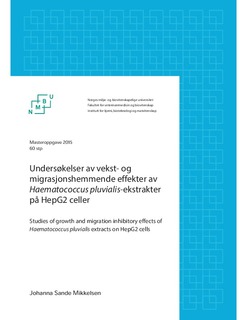| dc.contributor.author | Mikkelsen, Johanna Sande | |
| dc.date.accessioned | 2015-12-03T13:07:00Z | |
| dc.date.available | 2015-12-03T13:07:00Z | |
| dc.date.issued | 2015-12-03 | |
| dc.identifier.uri | http://hdl.handle.net/11250/2366754 | |
| dc.description.abstract | Tidligere studier har vist at mikroalgen Chlorella sorokiniana har migrasjons hemmende og apoptose-induserende egenskaper på HepG2 humane hepatocellulært karsinomceller (Chung et al. 2012). Nagaraj et al. (2012) studerte også effekten av mikroalger på HepG2 celler. I studiene observerte de en proliferasjonshemmende effekt på HepG2 cellene under påvirkning av astaxanthin fra Haematococcus pluvialis.
I dette studiet ble H. pluvialis ekstrahert med ulike løsningsmidler (vann og etanol) for å studere effekten av algeekstraktene. Ekstraktene ble benyttet for å undersøke mulige vekst- og migrasjonshemmende effekter av H. pluvialis på HepG2 celler. I tillegg ble det utført en viabilitetstest på WI-38 lunge fibroblastceller og den SV40-transformerte varianten WI-38 VA-13 under påvirkning av ekstraktene.
Celleviabiliteten til cellelinjene eksponert for ekstrakter fra H. pluvialis ble analysert ved hjelp av 3-(4,5-dimetyltiazol-yl)-2,5-difenyltetrazolium bromid (MTT) assay. Viabiliteten ble undersøkt etter 48 timer inkubasjon. Den største effekten ble observert på HepG2 og WI-38 VA-13 inkubert med H. pluvialis ekstrahert med vann. Flowcytometrisk analyse ble brukt for å undersøke HepG2 cellenes proliferasjon under påvirkning av ekstrakter fra H. pluvialis. For cellesyklusanalysen ble inkubasjonstiden til HepG2 cellene eksponert for ekstrakter fra H. pluvialis studert, i tillegg til ekstraktkonsentrasjonene. Migrasjonen til HepG2 cellene ble undersøkt ved hjelp av migrasjonstesten utviklet av Erkell og Schirrmacher (1988).
H. pluvialis ekstrahert med vann og etanol hadde ulik effekt på viabiliteten til HepG2, WI-38 og WI-38 VA-13. Det ble ikke observert proliferasjonshemmende eller migrasjonshemmende effekt fra H. pluvialis på HepG2. Resultatene fra viabilitetstesten viste en toksisk effekt på kreftcellene (HepG2 og WI-38 VA-13) som var eksponert med vannekstraktet. Videre studier er nødvendig for å kartlegge hvilke metabolittene man har i ekstraktene, og hvilken funksjon de har på hverandre og kreftcellene. | nb_NO |
| dc.description.abstract | Previous studies have shown that the microalgae
Chlorella sorokiniana
has anti-invasion and
apoptosis induction activity on HepG2 human hepatocellular carcinoma cells (Chung et al.
2012). Nagaraj et al. (2012) studied the effect of microalgae on HepG2 cells. The studies
showed an antiproliferative effect on HepG2 cells under the influence of astaxanthin from
Haematococcus pluvialis
.
In this thesis,
H. pluvialis
was extracted with various solvents (water and ethanol) to study the
effects of algae extracts. The extracts was used to examine the potential growth and migration
inhibitory effects of
H. pluvialis
on HepG2 cells. In addition, it was performed a viability test
on WI-38 lung fibroblast cells and the SV40-transformed variant WI-38 VA-13 under the
influence of the extracts.
Cell viability of the cell lines exposed to extracts from
H. pluvialis
was analyzed by 3-(4,5-
dimethylthiazol-yl)-2,5-diphenyltetrazolium bromide (MTT) assay. The viability was studied
after 48 hours incubation. The biggest impact was observed in HepG2 and WI-38 VA-13
incubated with
H. pluvialis
extracted with water. Flow cytometric analysis was used to
examine the proliferation in HepG2 cells under the influence of extracts from
H. pluvialis
. For
the cell cycle analysis, the incubation time for HepG2 cells exposed to extracts from
H.
pluvialis
was studied, in addition to the extract concentrations.
Migration of HepG2 cells were
examined by using the migration assay developed by Erkell og Schirrmacher (1988).
H
.
pluvialis
extracted with water and ethanol had different effects on the viability of HepG2,
WI-38 and WI-38 VA-13. There was no evidence of proliferation or migration inhibitory
effects of
H. pluvialis
on HepG2 cells. Results from viabilitetstesten showed a toxic effect on
cancer cells (HepG2 and WI-38 VA-13) that was exposed by the water extract. Further studies
are needed to identify the metabolites in the extracts, along with the functions they have one
each other and on cancer cells. | nb_NO |
| dc.language.iso | nob | nb_NO |
| dc.publisher | Norwegian University of Life Sciences, Ås | |
| dc.rights | Navngivelse 3.0 Norge | * |
| dc.rights.uri | http://creativecommons.org/licenses/by/3.0/no/ | * |
| dc.subject | Cancer | nb_NO |
| dc.subject | Haematococcus pluvialis | nb_NO |
| dc.subject | HepG2 | nb_NO |
| dc.subject | Matastasis | nb_NO |
| dc.title | Undersøkelser av vekst- og migrasjonshemmende effekter av Haematococcus pluvialis-ekstrakter på HepG2 celler | nb_NO |
| dc.title.alternative | Studies of growth and migration inhibitory effects of Haematococcus pluvialis extracts on HepG2 cells | nb_NO |
| dc.type | Master thesis | nb_NO |
| dc.subject.nsi | VDP::Mathematics and natural science: 400::Basic biosciences: 470::Molecular biology: 473 | nb_NO |
| dc.source.pagenumber | 73 | nb_NO |
| dc.description.localcode | M-MB | nb_NO |

